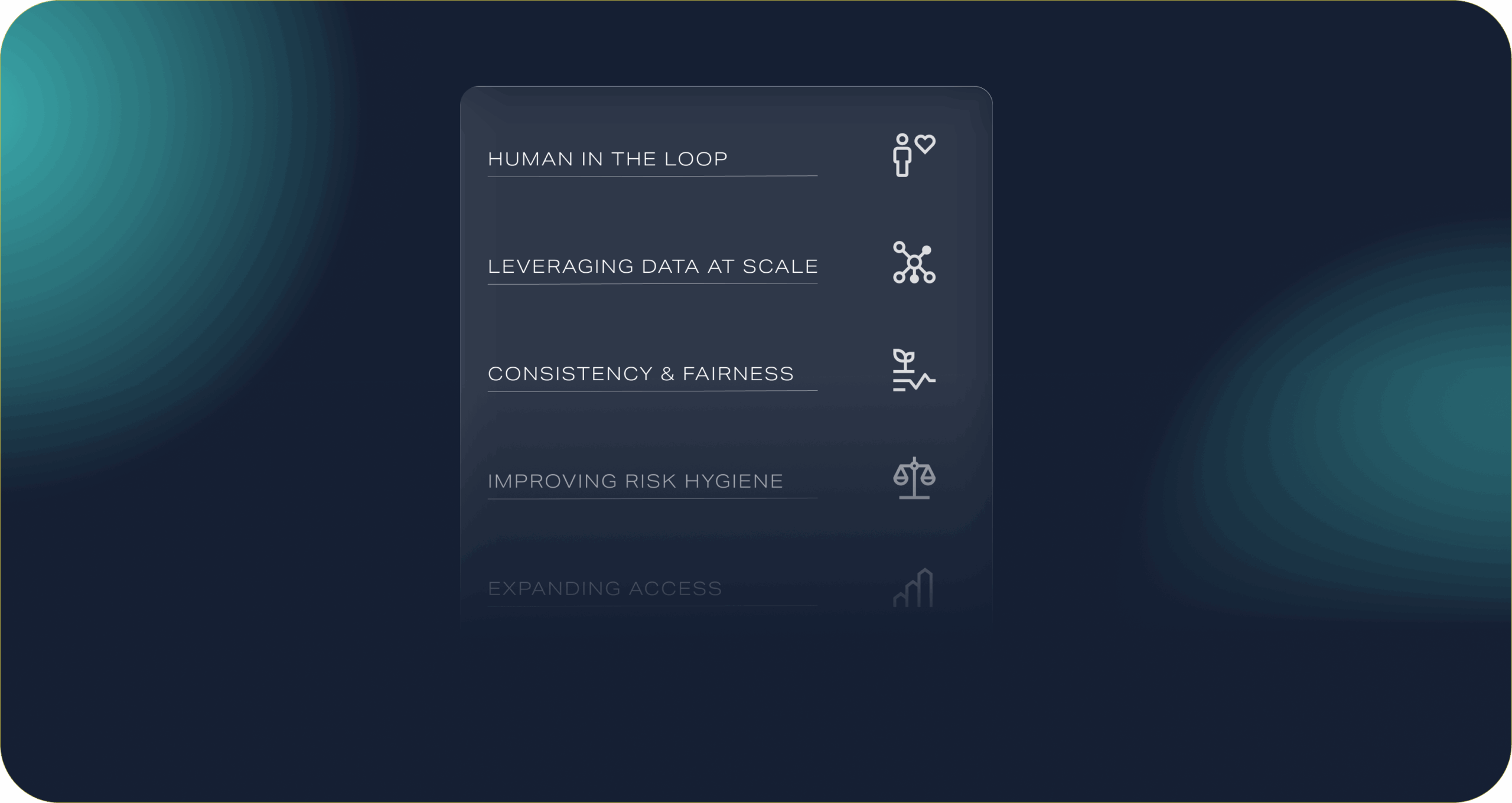What is machine learning?

What is machine learning, and its impact on lending?
What is Machine Learning? In simple terms, machine learning (ML) is a branch of artificial intelligence (AI) that focuses on predicting outcomes. It analyzes large amounts of data and identifies trends to support better decision-making. Specifically for lenders, sophisticated ML models can help identify less risky borrowers who may be missed due to a lack of accuracy with generic credit scoring methods and models.
Machine learning also helps lenders in the fight against fraud. Advancements in AI have unfortunately also led to an increase in fraudulent activities by bad actors. ML has become a powerful tool for lenders to identify and stop fraud in the loan origination process.
It’s clear that AI and ML are transforming the financial industry, and to stay competitive, financial institutions must consider adopting AI tools. Let’s take a closer look at how ML is helping lenders, starting with why it’s more effective than traditional credit scoring methods.
Traditional credit scoring vs. machine learning for underwriting
Traditional methods of credit scoring and underwriting have heavily relied on human-designed rules with limited data. These methods are commonly built using logistic regression models that consider a limited number of factors, such as payment history, debt-to-income ratio, credit age, etc. If an applicant’s profile doesn’t fit within the established criteria (for example, if they have limited credit history), the traditional method may score them poorly or not at all. In the U.S., it’s estimated that 45 million people have little to no credit history, which means they’re “credit invisible.” That’s a huge segment of potential borrowers who may be creditworthy but get overlooked by one-size-fits-all models.
Machine learning-based underwriting takes a very different approach. Instead of relying on limited data, ML models can efficiently analyze large volumes of data in a relatively short amount of time. Lenders using Zest AI-developed ML models can often use 10 to 100 times more data variables than they could before. As one report put it, a conventional credit score provides a “grainy, pixelated image” of a borrower, whereas an ML model yields a “high-definition, 3D video” by examining hundreds of factors.
Let’s explore the potential benefits lenders are experiencing with machine learning.
Three ways machine learning is transforming lending
Machine learning’s ability to analyze vast amounts of data is transforming key aspects of lending, including:
1. Expanding credit access with greater accuracy
One of the main benefits of machine learning is that it helps lenders expand access to credit without sacrificing risk standards. The accuracy of risk prediction improves alongside the increase in approvals. For example, a lender could reduce risk over 20% while continuing to maintain or increase approval rates. This ability to expand the creditworthy customer base without “turning the dial” up on risk is a game-changer for lenders.
As previously mentioned, machine learning models can evaluate individuals with thin files, meaning very little credit history, by generating more insights from credit reports over a longer duration. They may also incorporate alternative data in a compliant manner.
By using AI-automated underwriting developed by Zest AI, lenders can confidently score over 90% of the U.S. population, including segments that traditional models left out, enabling roughly 25% more loan approvals. In fact, lenders using Zest AI’s sophisticated machine learning technology have seen a significant increase in approval rates for borrowers of color and other protected classes—on average, 49% higher approval rates for Latino applicants, 41% for Black applicants, 31% for AAPI, and 40% for women.
2. Enhancing operational efficiency and speed
In addition to better credit decisions, machine learning is supercharging operational performance for lenders. Traditional loan underwriting is labor-intensive: manual review of files, applying policy rules, and double-checking calculations. AI automates large parts of this process, allowing lenders to handle higher volumes with greater speed and consistency. Faster decisions not only reduce the cost of processing loan applications, but also improve customer satisfaction. Borrowers aren’t left waiting for days or weeks to hear back.
Consistency is also an operational benefit, as humans can be inconsistent. Two underwriters might reach slightly different decisions on the same borrower, or the same underwriter might be tougher in the morning and more lenient in the afternoon. Machine learning models, by contrast, apply the same criteria every time without fatigue or bias, resulting in more consistent credit decisions. This reduces error rates and the need for rework or overrides.
Zest AI’s underwriting models are trained utilizing supervised machine learning methods (not self-learning) and are “locked” while in production (does not continue to learn based on new production data). As such, Zest AI can support compliance efforts with its model risk management documentation. The transparency and explainability of Zest AI models allow lenders to operate with confidence and security while enjoying greater efficiency.
3. Strengthening fraud detection and security
Whether it’s catching identity theft in loan applications or flagging potential first-party malicious intent, ML models can spot anomalies that may be missed in a manual review. Fraud detection is critical as lenders have to contend with increasingly sophisticated fraudsters (like deepfake identities or fake documents). The scale of the fraud challenge is massive. For example, the FTC estimates that consumer fraud losses exceeded $10 billion in 2023.
Leveraging AI for defense against AI fraud is becoming a necessity. As one credit union executive put it, “Capturing application fraud, especially more sophisticated AI-powered fraud, without compromising the member experience, is a top priority for us,” said Gather Federal Credit Union’s EVP, Justin Ganaden. “The insights, accuracy, and end-to-end automation we have experienced with Zest AI technology has transformed our lending business.”
It’s evident why AI and ML are becoming table stakes for lenders, and why it’s the key to staying ahead of the competition.
Machine learning is necessary to stay competitive
Machine learning is becoming mainstream in financial services. A recent industry survey found that 73% of banks are already using AI/ML models or tools in some capacity. Large U.S. banks led the charge initially, but now even mid-sized and community institutions are adopting ML.
The trend is clear: the majority of financial institutions are embracing machine learning, and those that haven’t yet are actively evaluating it.
Competitive stakes are high. Lenders that still require lengthy manual reviews could see higher dropout rates and lose market share to more tech-forward competitors, especially among younger generations. Digital-native borrowers will lean toward lenders who offer fast, fair, and tailored credit decisions.
Of course, adopting ML doesn’t mean throwing caution to the wind. The rise of AI models has prompted regulators and industry groups to issue guidance on managing these models. The good news is that the industry is coalescing around best practices to ensure ML is used responsibly. Model risk management frameworks have evolved to include tests for disparate impact and bias in AI models, and techniques like model explainers can translate a complex model’s output into reasons easily understood by humans. Zest AI software includes built-in tools to generate compliance-friendly documentation, and Zest monitors model performance for drift or anomalies over time.
Navigate machine learning with Zest AI
Lenders leveraging machine learning can make more accurate and fair credit decisions, extend credit to less risky borrowers previously left out, streamline their operations, and protect against fraud–all key factors to staying competitive in a fast-evolving financial landscape.
Discover for yourself how much you can gain by incorporating AI-Automated Underwriting.
To learn more about machine learning, download our Machine Learning 101 eBook. If you’re ready to dive in, schedule a call with our team to get your proof of concept.

